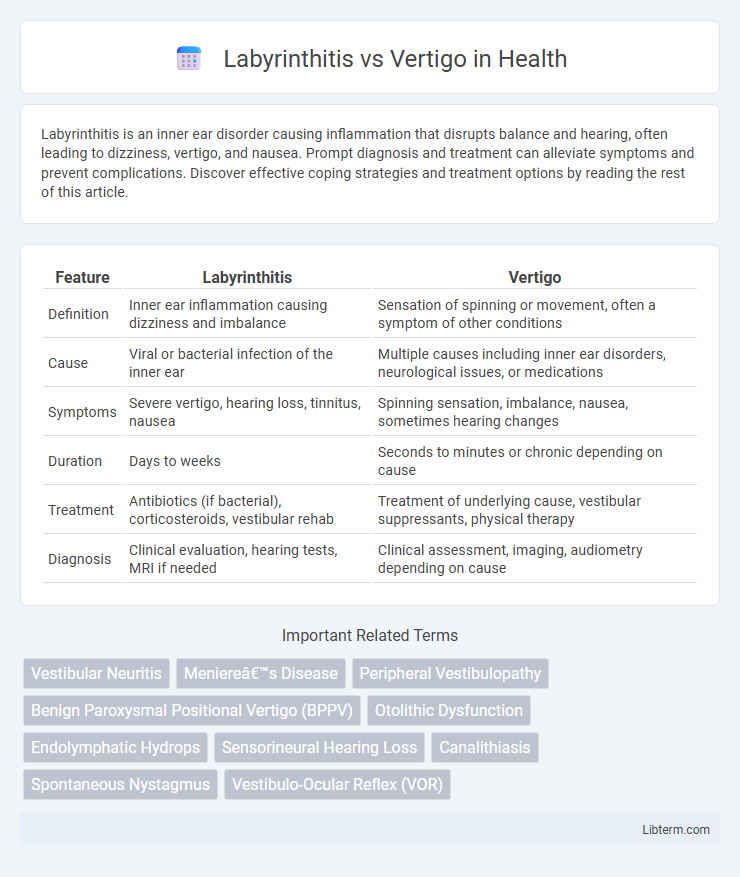Labyrinthitis is an inner ear disorder causing inflammation that disrupts balance and hearing, often leading to dizziness, vertigo, and nausea. Prompt diagnosis and treatment can alleviate symptoms and prevent complications. Discover effective coping strategies and treatment options by reading the rest of this article.
Table of Comparison
| Feature | Labyrinthitis | Vertigo |
|---|---|---|
| Definition | Inner ear inflammation causing dizziness and imbalance | Sensation of spinning or movement, often a symptom of other conditions |
| Cause | Viral or bacterial infection of the inner ear | Multiple causes including inner ear disorders, neurological issues, or medications |
| Symptoms | Severe vertigo, hearing loss, tinnitus, nausea | Spinning sensation, imbalance, nausea, sometimes hearing changes |
| Duration | Days to weeks | Seconds to minutes or chronic depending on cause |
| Treatment | Antibiotics (if bacterial), corticosteroids, vestibular rehab | Treatment of underlying cause, vestibular suppressants, physical therapy |
| Diagnosis | Clinical evaluation, hearing tests, MRI if needed | Clinical assessment, imaging, audiometry depending on cause |
Understanding Labyrinthitis and Vertigo
Labyrinthitis is an inner ear disorder characterized by inflammation affecting the labyrinth, causing sudden vertigo, hearing loss, and imbalance. Vertigo, a symptom rather than a condition, refers to the false sensation of spinning or movement often triggered by inner ear problems like labyrinthitis. Accurate diagnosis distinguishing labyrinthitis from other vestibular disorders is crucial for effective treatment and symptom management.
Defining Labyrinthitis: Causes and Symptoms
Labyrinthitis is an inner ear disorder caused by inflammation of the labyrinth, often resulting from viral or bacterial infections. Common symptoms include sudden onset dizziness, vertigo, hearing loss, tinnitus, and balance disturbances. Unlike benign paroxysmal positional vertigo (BPPV), labyrinthitis affects both hearing and equilibrium due to labyrinth inflammation.
What is Vertigo? Key Features and Triggers
Vertigo is a sensation of spinning or dizziness often caused by inner ear problems affecting balance, such as benign paroxysmal positional vertigo (BPPV), vestibular neuritis, or labyrinthitis. Key features include a false sense of motion, nausea, vomiting, and difficulty maintaining balance, typically triggered by head movements or changes in position. Unlike labyrinthitis, which involves inflammation of the inner ear and may present with hearing loss, vertigo primarily centers on balance disruption without necessarily affecting hearing.
Main Differences Between Labyrinthitis and Vertigo
Labyrinthitis is an inner ear disorder characterized by inflammation of the labyrinth, causing vertigo, hearing loss, and balance issues, whereas vertigo is a symptom describing a sensation of spinning or dizziness without specifying the underlying cause. Labyrinthitis typically presents with sudden onset of vertigo accompanied by auditory symptoms like tinnitus or hearing impairment, while vertigo alone may arise from various conditions including benign paroxysmal positional vertigo (BPPV), vestibular neuritis, or central nervous system disorders. Diagnostic differentiation relies on clinical history, audiometric testing, and vestibular function evaluations to distinguish labyrinthitis from other causes of vertigo.
Common Causes of Labyrinthitis
Labyrinthitis commonly arises from viral infections, such as the herpes simplex virus or influenza, which inflame the inner ear's labyrinth, causing dizziness and balance disturbances. Bacterial infections, including middle ear infections, can also lead to labyrinthitis by spreading inflammation to the labyrinth. Unlike general vertigo, which may result from various causes like benign paroxysmal positional vertigo (BPPV) or Meniere's disease, labyrinthitis specifically involves inner ear inflammation triggered by infectious agents.
Typical Causes of Vertigo
Vertigo commonly results from inner ear disorders such as benign paroxysmal positional vertigo (BPPV), vestibular neuritis, and Meniere's disease, all of which affect balance and spatial orientation. Labyrinthitis, a specific type of inner ear infection causing inflammation, leads to vertigo accompanied by hearing loss and tinnitus. While vertigo is a symptom describing a spinning sensation, labyrinthitis refers to an underlying cause involving the labyrinth, a crucial structure in the vestibular system.
Diagnosing Labyrinthitis vs Vertigo
Diagnosing labyrinthitis involves identifying inflammation of the inner ear, typically confirmed through clinical history of recent viral infections, hearing loss, and balance tests such as audiometry and electronystagmography. Vertigo diagnosis focuses on determining the root cause of the spinning sensation, often using the Dix-Hallpike maneuver for benign paroxysmal positional vertigo (BPPV) or imaging studies like MRI to rule out central nervous system disorders. Differentiating labyrinthitis from vertigo requires assessing accompanying symptoms like tinnitus and ear fullness with labyrinthitis, while vertigo caused by vestibular migraine or Meniere's disease presents distinct clinical profiles.
Treatment Options for Labyrinthitis
Treatment options for labyrinthitis primarily involve corticosteroids to reduce inner ear inflammation and antiviral medications if a viral infection is suspected. Supportive care includes vestibular rehabilitation exercises to improve balance and anti-nausea drugs like meclizine to manage symptoms. In most cases, symptoms resolve within a few weeks with proper medical intervention and rest.
Managing and Treating Vertigo
Managing and treating vertigo involves addressing underlying causes such as labyrinthitis through medications like vestibular suppressants, corticosteroids, and anti-nausea drugs to reduce inflammation and relieve symptoms. Vestibular rehabilitation therapy (VRT) plays a critical role by improving balance and reducing dizziness through tailored exercises that enhance vestibular compensation. Avoiding triggers, ensuring hydration, and following medical guidance for specific conditions like benign paroxysmal positional vertigo (BPPV) with maneuvers like the Epley maneuver optimize recovery and prevent recurrence.
Preventive Measures and When to Seek Help
Preventive measures for labyrinthitis and vertigo include avoiding upper respiratory infections through good hygiene, managing allergies effectively, and reducing exposure to known triggers such as sudden head movements or stress. Maintaining hydration, practicing balance exercises, and controlling underlying conditions like hypertension can lower the risk of both vestibular disorders. Seek medical help promptly if symptoms include severe dizziness, hearing loss, persistent imbalance, or neurological signs such as weakness or vision changes to rule out more serious conditions.
Labyrinthitis Infographic

 libterm.com
libterm.com